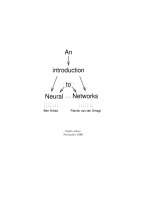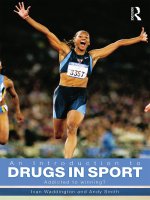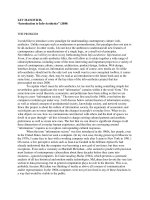An Introduction to Drugs in Sport pptx
Bạn đang xem bản rút gọn của tài liệu. Xem và tải ngay bản đầy đủ của tài liệu tại đây (2.18 MB, 281 trang )
An Introduction to Drugs in Sport
Why do many athletes risk their careers by taking performance-enhancing
drugs? Do the highly competitive pressures of elite sports teach athletes to
win at any cost? An Introduction to Drugs in Sport provides a detailed and sys-
tematic examination of drug use in sport and attempts to explain why ath-
letes have, over the last four decades, increasingly used performance-enhancing
drugs. It offers a critical overview of the ma jor theories of drug use in sport,
and provides a detailed analysis of the involvement of sports physicians in
the development and use of performance-enhancing drugs. Focusing on drug
use within elite sport, the book offers an in-depth examination of important
contemporary themes and issues, including:
the history of drugs in sport and changing patterns of use
fair play, cheating and the ‘spirit of sport’
WADA and the future of anti-doping policy
drug use in professional football and cycling
sociological enquiry and the probl ems of researching drugs in sport
Designed to help students explore and understand this problematic area of
research in sport studies, and richly illustrated throughout with case studies
and empirical data, An Introduction to Drugs in Sport is an invaluable addition
to the literature. It is essential reading for anybody with an interest in the
relationship between drugs, sport and society.
Ivan Waddington is Visiting Professor at the Norwegian School of Sport
Sciences, Oslo and the University of Chester, UK. He is the author of Sport,
Health and Drugs (Routledge, 2000) and co-editor of Sport Histories (Routledge,
2004) and Pain and Injury in Sport (Routledge, 2006).
Andy Smith is Senior Lecturer and Co-Director of the Chester Centre for
Research into Sport and Society at the University of Chester, UK. He is
co-editor of the International Journal of Sport Policy and co-author of Sport
Policy and Development (Routledge, 2009) and Disability, Sport and Society
(Routledge, 2009).
An Introduction to
Drugs in Sport
Addicted to winning?
Ivan Waddington and Andy Smith
First edition published 2009
by Routledge
2 Park Square, Milton Park, Abingdon, Oxon, OX14 4RN
Simultaneously published in the USA and Canada
by Routledge
270 Madison Avenue, New York, NY 10016
Routledge is an imprint of the Taylor & Francis Group, an informa business
© 2009 Ivan Waddington and Andy Smith
All rights reserved. No part of this book may be reprinted or reproduced
or utilized in any form or by any electronic, mechanical, or other means,
now known or hereafter invented, including photocopying and recording,
or in any information storage or retrieval system, without permission in
writing from the publishers.
British Library Cataloguing in Publication Data
A catalogue record for this book is available from the British Library
Library of Congress Cataloging in Publication Data
Waddington, Ivan.
An introduction to drugs in sport : addicted to winning? / by Ivan
Waddington and Andy Smith.
p. cm.
1. Doping in sports. I. Smith, Andy. II. Title.
RC1230.W294 2009
362.29–dc22 2008025173
ISBN 978-0-415-43124-8 (hbk)
ISBN 978-0-415-43125-5 (pbk)
ISBN 978-0-203-88598-7 (ebk)
This edition published in the Taylor & Francis e-Library, 2008.
“To purchase your own copy of this or any of Taylor & Francis or Routledge’s
collection of thousands of eBooks please go to www.eBookstore.tandf.co.uk.”
ISBN 0-203-88598-8 Master e-book ISBN
For Ella,
who has brought such joy.
And to Mom, Dad and Jenny,
for their support.
Contents
Preface ix
Introduction 1
1 Drug use in sport: problems of involvement and detachment 9
2 The emergence of drug use as a problem in modern sport:
sport, health and drugs 16
3 The emergence of drug use as a problem in modern sport:
fair play, cheating and the ‘spirit of sport’ 35
4 Theories of drug use in elite level sport 48
5 Drug use in elite level sport: towards a sociological
understanding 64
6 The other side of sports medicine: sports medicine and the
development of performance-enhancing drugs 83
7 The recent history of drug use in British sport: a case study 102
8 Drug use in professional cycling: a case study 129
9 Drug use in professional football: a case study 155
10 The establishment of the World Anti-Doping Agency 179
11 Anti-doping policies in sport: whither WADA? 200
12 Anti-doping policies in sport: new directions? 217
Notes 235
Bibliography 238
Index 251
Preface
When we started work on this book our intention was to produce a revised
and updated version of Ivan Waddington’s book, Sport, Health and Drugs.
That book had been published in 2000 and, given that the world of drugs in
sport is a rapidly changing one, it was certainly due for a revision. However
in the course of writing this book, it has changed into something rather
different.
Readers of Sport, Health and Drugs ma y recall that it was divided into two
related, but rather different, sections. The first section consisted of four
chapters which examined different aspects of the relationship between sport
and health, while the second part consisted of six chapters which focused
on sport and drugs; these different but related issues were appropriately
encapsulated in the title of that earlier book. For the current book, we have
omitted altogether the four chapters which focused on health issues and
these have been replaced by six new chapters on drug use in sport. In
addition, the original chapters on drugs in the earlier volume have all been
updated and revised and, in most cases, expanded. In several respects,
therefore, the new book is considerably more than simply an updated ver-
sion of the earlier book; with the removal of the entire section on health
and the inclusion of the six new chapters, this book focuses exclusively on
drug use in sport. We believe that these changes are sufficiently radical and
far-reaching to justify the change of title.
Writing a book, as any sociologist will recognize, is a social activity (even
in the case of sole-authored books, which this is not), so it is appropriate to
thank the many people who, over many years, have encouraged us and
contributed, directly or indirectly, to our development as sociologists and
to the development of our thought in relation to drug use in sport.
Particular mention should be made of former colleagues at the University
of Leicester, and especially Eric Dunning, Patrick Murp hy, Ken Sheard,
Dominic Malcolm and Martin Rode rick. We would also like to thank our
colleagues at the University of Chester, especially Ken Green, Daniel
Bloyce, Katie Liston and Chris Platts for their encouragement and support.
Since the University of Leicester, in an act of crass intellectual vandalism,
closed the world-ranked Centre for Research into Sport and Society in
2002 (because it was not making enough money!), Ivan Waddington has
enjoyed the great pleasure of working as a Visiting Professor at the Centre
for Sports Studies, University College Dublin and at the Norwegian School
of Sport Sciences, Oslo. Thanks are due to all the special friends who have
been so welcoming and supportive in both places and particularly to Conal
Hooper and Karen Hennessy in UCD and to Sigmund Loland and Berit
Skirstad in Oslo. Ivan Waddington would also like to thank his fellow
cyclist and clubmate, Peter Witting, who has been assiduous in providing
information from appropriate cycling websites on all the information about
the latest (and very frequent!) revelations relating to drug use in cycling.
Finally we should like to record our thanks to Dominic Malcolm, now at
Loughborough Uni versity, who was a co-author of Chapter 9, and to Dag
Vidar Hanstad, of the Norwegian School of Sports Sciences, Oslo, who was
a co-author of Chapter 10.
x Preface
Introduction
It may be useful at the outset to make clear to the reader what this book is
about and, equally importantly, what it is not about. It may also be useful
to set out some of the conceptual and theoretical issues which underpin
this book.
First, we should make it clear that the focus of this book is consistently
on drug use in elite sport. We are of course aware of the fact that far more
performance-enh ancing drugs are consumed outside the context of elite
sport, for example, in gymnasiums. We are also aware of the fact that the
widespread consumption, particularly of anabolic steroids, by bodybuilders
and many others who use such drugs for cosmetic purposes, constitutes a
far more serious public health issue than does drug use by elite athletes,
partly because of the much larger number of people involved – in 1994 it
was estimated that in a city the size of London there may be as many as
60,000 regular users of anabolic steroids (Walker, 1994) – and partly
because gym users and non-competitive athletes who use steroids are much
less likely than are elite athletes to be using the drugs under medical
supervision. We make some reference to the use of anabo lic steroids out-
side the context of elite sport in Chapter 7, but this is not our primary
concern in this book. Those who wish to examine these issues in more
detail will find excellent starting point s in the books by Monaghan (2001)
and Lenehan (2003).
Second, we need to d raw attention to an important conceptual issue
concerning our use of the terms ‘doping’ and the ‘use of performance-
enhancing drugs’. Dunning and Waddington (2003: 364) have suggested that
‘it may be useful to differentiate between these terms and to apply them to
two rather different ways in which drugs may be used to affect sporting
performance’. The first of these relates to situations in which athletes
knowingly take drugs with a view to enhancing their performance, or in
which they inadvertently take them, for exam ple by consuming a legitimate
medication which also contains a performance-enhancing substance, such as
ephedrine, which is contained in some common cold remedies. In both
cases, it is assumed under the rules of strict liability that the athlete can be
held responsible for the consumption of the drug and it is on this basis
that sanctions may be applied. In other cases, however, the assumption of
personal responsibility may not be valid, for substances which affect per-
formance may also be administered without the knowledge or consent of
the ‘competitor’.
Dunning and Waddington deliberately used the term ‘competitor’ in
inverted commas because the most obvious example of drugs being used
without the knowledge or cons ent of the ‘competitor’ concerns animal
sports, where drugs may often be administered to animals not with a view
to enhancing, but to hindering, their performance. However, they add that
‘there have been situations in which performance-enhancing drugs are
administered to human athletes without their knowledge or consent and in
situations in which it may not be appropriate to hold the drug-us ing ath-
letes responsible for their consumption of those drugs’ (Dunning and
Waddington, 2003: 365). In this regard, they cite the state-sponsored doping
system in former East Germany, under which large numbers of athletes,
many of them children, were given drugs without their knowledge or con-
sent and they suggest that ‘it may be appropriate to regard those who were
administered drugs under these circumstances not as criminal or cheats
but – especially in view of the drug-related health problems experienced by
some former East German athletes –‘as “victims” or “dupes”’ (Dunni ng
and Waddington, 2003: 365).
They suggest that:
In the light of situations such as those outlined above, it might be
useful to restrict the use of the term ‘doping’ to those situations in
which drugs which affect performance are administered without
informing, or securing the consent of, those who receive these drugs.
Such situations may arise because the issues of providing information
and securing consent are not relevant because those receiving the
drugs are non-human, as opposed to human, animals. However, such
situations may also arise, as in the case of athletes in East Germany,
because the structure not only of the sport system but also of the wider
socio-economic-political system – and in particular, the bala nce of
individual and collective rights – is conducive to the administration of
drugs to athletes without their consent. In contrast to these situations,
it is our suggestion that, where an athlete him/herself is knowingly
taking performance-enhancing drugs, or where he/she may be held
culpable for not taking adequate precautions to avoid ingesting such
drugs, even accidentally, it is useful to describe such behaviour not as
‘doping’ but as ‘behaviour involving the u se of performance-enhancing
drugs’. The central rationale for making this distinction is that
situations in which people (or non-human animals) are ‘doped’ involve
a very different pattern of social relationships from those in which
athletes may be held responsible for their consumption of perfor-
mance-enhancing drugs. In addition, the legal cons equences are likely
2 Introduction
to be very different, while the two situations are also likely to be morally
evaluated quite differently.
(Dunning and Waddington, 2003: 365–66)
We have, throughout this book, sought to maintain the distinction recom-
mended by Dunning and Waddington. For the most part, we have therefore
referred to ‘drug use’ or the ‘use of drugs’ rather than to ‘doping’ in sport.
However, where we have referred to the systematic use of drugs in state-
sponsored systems such as those which existed in parts of Eastern Europe,
we have used the term ‘doping’. We have, of course, also retained the term
‘doping’ where it is used in official titles, such as the World Anti-Doping
Agency or the World Anti-Doping Conference, and where we have directly
cited other authors who have used the term. Finally, we have also continued
to use the ter m ‘doping’ in relation to a few are as where i ts use is well established
in some aspects o f o fficial policy, such as ‘anti-doping p olicies’.
Third, it is appropriate to say something about the theoretical perspective
which underlies this book. The general approach on which we have drawn
is that of figurational or process sociology, which has grown out of the
work of Norbert Elias (1897–1990). For the most part, this perspective has
been used here implicitly in order to limit the more explicitly theoretical
aspects of the book and thus make it as accessible as possible to those who
have an interest in sport, but who do not have a grounding in sociological
theory. The one exception to this is to be found in Chapter 10, where we
have found it necessary to provide an outline of Elias’s game models, since
we draw on these game models quite explicitly in order to try to understand
the circumstances surrounding the establishment of the World Anti-Doping
Agency (WADA) in 1999.
With this one exception, however, we have not thought it necessary to
describe in detail the central organizing concepts of figurational sociology,
such as the concept of ‘figuration ’ itself, or the closely related concepts of
interdependency ties and power balances or power ratios. Similarly, we
have not thought it necessary to describe how Elias’s concept of ‘figuration’
helps us to overcome some of the problems associated with traditional and
unhelpful dichotomies in sociology, such as those between the ‘individual’
and ‘society’,or‘social structure’ and ‘social change’. This has been done
elsewhere (Murphy et al., 2000). Readers who wish to find out more about
Elias’s general sociological work might usefully consult the excellent works
by Mennell (1992) and van Krieken (1998), while those who wish to find out
more about how figurational or proc ess sociology and, in particular, Elias’s
work on civili zing processes, has been applied to sport might look at any of
the sport-related works by Elias and/or Dunning listed in the bibliography
to this book. However, it may be helpful to say something about one key
aspect of Elias’s work on which we have drawn explicitly and which pro-
vides a central integrating theme for the book as a whole. This key aspect
relates to Elias’s writing on involvement and detachment.
Introduction 3
Throughout this book, we have sought to offer a relatively detached
analysis of modern sport. We deliberately use the term ‘relatively detached’
rather than ‘objective’ because, following Elias, we believe the concepts of
involvement and detachment have several advantages over the more com-
monly used terms ‘objectivity’ and ‘subjectivity’.
Elias suggested that one of the problems with concepts like ‘objectivity’
and ‘subjectivity’ is that they tend to suggest a static and unbridgeable
divide between two entities –‘subject’ and ‘object’–and closely associated
with this is the almost ubiquitous tendency, among those who use these
terms, to describe research in all-or-nothing terms, that is to describe it
as either totally ‘objective’ or, conversely, as completely lacking objectivity,
i.e. as being ‘subjective’ in an absolute sense.
Clearly such a conceptualization is of little use, for – to stick with these
terms for the moment – it is impossible to find an example of thinking
which is absolutely ‘objective’, and it is extremely difficult to find examples,
at least among sane adults, of thinking which is wholly ‘subjective’ in char-
acter. Equally, it is not possible in these terms adequately to describe the
development of modern science, for this development was a long-term
process, and there was not a single, historic, momen t when ‘objective’ scien-
tific knowledge suddenly emerged, fully formed, out of what had formerly
been wholly ‘subjective’ forms of knowledge.
What is required, Elias argued, is a more adequate conceptualization of
our ways of thinking about the world, and of the processes as a result of
which our present, more scientific, ways of thinking about the world have
developed. Elias’s conceptualization of the problem in terms of degrees of
involvement and detachment is, it might be argued, more adequate than
conventional arguments for the following reasons:
(i) it does not involve a radical dichotomy between categories such as
‘objective’ and ‘subjective’
, as though these were mutually exclusive
categories;
(ii) this conceptualization is processual, i.e. it provides us with a frame-
work with which we can examine the development, over time, of more
scientific (or what Elias called more object-adequate or alterna tively
more reality-congruent) knowledge.
It is important to emphasize that Elias emphatically denies the possibility
that the outlook of any sane adult can be either wholly detached or wholly
involved. Normally, he notes, adult behaviour lies on a scale somewhere
between these two extremes. Thus the concepts of involvement and detach-
ment ‘do not refer to two separate classes of objects … what we observe are
people and people’s manifestations, such as patterns of speech or of
thought … some of which bear the stamp of higher, others of lesser
detachment or involvement’ (Elias, 1987: 4). Clearly, therefore, Elias is not
suggesting that it is possible for us to obtain ‘ultimate trut h’, or complete
4 Introduction
detachment.
1
It is certainly not our claim to offer in this book anything
remotely resembling ‘ultimate truth’–whatever that might be – or complete
detachment; what we do hope to offer is a relatively detached perspective
which helps to advance, in some small way, our understanding of some key
aspects of the relationships between sport and the use of performance-
enhancing drugs.
But how can we differentiate between attitudes or knowledge which
reflect a relatively high degree of involvement, and those which reflect a
higher degree of detachment? Why should we, as sociologists, seek to
achieve a higher degree of detachment in our work? And what are the pro-
cesses which, over a long period of time, have gradually enabled people to
think, first about the ‘natural’ world, and then, more recently, about the
‘social’ world, in more detached terms? These questions can be best
explored via a consideration of Elias’s essay, ‘The fishermen in the mael-
strom’ (Elias, 1987: 43–118).
Elias begins his essay by retelling an episode from Edgar Allan Poe’s
famous story about the descent into the maelstrom. Those who are familiar
with the story will recall that two brothers who were fishermen were caught
in a storm and were slowly being drawn into a whirlpool. At first, both
brothers – a third brother had already been lost overboard – were too ter-
rified to think clearly and to observe accurately what was going on around
them. Gradually, however, the younger brother bega n to control his fear.
While the elder brother remained paralysed by his fear, the younger man
collected himself and began to observe what was happening around him,
almost as if he were not involved. It was then that he became aware of cer-
tain regularities in the movement of objects in the water which were being
driven around in circles before sinking into the whirlpool. In short, while
observing and reflecting, he began to build up an elementary ‘theory’ relat-
ing to the movement of objects in the whirlpool. He came to the conclusion
that cylindrical objects sank more slowl y than objects of any other shape,
and that smaller objects sank more slowly than larger ones. On the basis of
his observations and of his elementary ‘theory’, he took appropriate action.
While his brother remained immobilized by fear, he lashed himself to a
cask and, after vainly encouraging his brother to do the same, leapt
overboard. The boat, with his brother in it, descended rapidly into the
whirlpool. However, the younger brother survived, for the cask to which
he had lashed himself sank much more slowly, and the storm eventually
blew itself out before the cask was sucked down into the whirlpool.
The story of the fishermen points up very clearly a kind of circularity
which is by no means uncommon in the development of human societies.
Both brothers found themselves involved in processes – a storm and the
associated whirlpool – which appeared wholly beyond their control. Not
surprisingly, their emotional involvement in their situation paralysed their
reactions, making it difficult for them to analyze what was happening to
them, or to take effective action to maximize their chances of survival.
Introduction 5
Perhaps for a time they may have clutched at imaginary straws, hoping for a
miraculous intervention of some kind. After a while, however, one of the
brothers began, to some degree, to calm down. As he did so, he began to
think more coolly. By standing back, by controlling his fear, by seeing his
situation, as it were, from a distance – in other words, by seeing himself and
his situation in a rather more detached way – he was able to identify certain
patterns within the whirlpool. Within the general ly uncontrollable pro-
cesses of the whirlpool, he was then able to use his new-found knowledge of
these patterns in a way which gave him a sufficient degree of control to
secure his own survival. In this situation, we can see very clearly that the
level of emotional self-control, of detachment, and the development of more
‘realistic’ knowledge which enables us more effectively to control both
‘natural’ and ‘social’ processes, are all interdependent and complementary.
This same kind of circularity can also be seen in the reaction of the older
brother, who perished in the whirlpool. High exposure to the dangers of a
process tends to increase the emotivity of human responses. High emotivity
of response lessens the chance of a realistic understanding of the critical
process and, hence, of a realistic practice in relation to it. In turn, relatively
unrealistic practice und er the pressure of strong emotional involvement
lessens the chance of bringing the critical process under control. In short,
inability to control tends to go hand-in-hand with high emotivity of
response, which minimizes the chance of controlling the dangers of the
process, which keeps at a high level the emotivity of the response, and so
forth.
Insofar, therefore, as we are able to control our emotional involvement
with the processes we are studying, we are more likely to develop a more
realistic or ‘reality-congruent’ analysi s of those processes. Conversely, the
more emotionally involved we are, the more likely it is that our strong
emotional involvement will distort our understanding. It is this considera-
tion which constitutes the primary rationale for Elias’s argument that we
should seek, when engaged in research, to maintain a relatively high degree
of detachment.
But what, the reader may ask, has this to do with understanding drug use
in sport? Participation in sport, whether playing or spectating, has the
capacity to arouse high levels of emotion and excitement; indeed, as Elias
and Dunning (1986) have pointed out, it is precisely this capacity of sport to
generate relatively high levels of (often pleasurable) excitement which
accounts, at least in part, for its widespread popularity. However, it is
important to recognize that the relatively high level of emotion which sur-
rounds many sporting issues often has the effect of hindering, rather than
helping, the development of a more adequate understanding of modern
sport, and of the relationships between sport and other aspects of the wider
society. One obvious example concerns the use of performance-enhancing
drugs in sport, which is the focus of this book; drug use in sport typically
generates a great deal of emotion, and this in turn has often been associated
6 Introduction
with a tendency to substitute moral opprobrium and condemnation for
relatively detached analysis and understanding. However, the former –
however emotionally satisfying – constitutes a poor basis for policy forma-
tion. The problems of involvement and detachment in relation to drug use
in sport are examined in more detail in Chapter 1.
The search for a relatively detached understanding of the complex rela-
tionships betw een sport and drug use constitutes the central objective of
this book. Our perspective, it should be noted, almost inevitably leads us
to be critical of much of the existing literature and policy in this area, much
of which bears the hallmark of ideology and moral indignation rather than
scientific detachment. For example, we argue that, if we wish to understand
why athletes use performance-enhancing drugs then we have to move away
from the individualistic assumptions which have traditionally underpinned
policy in this area and move towards a focus on understanding the network
of rel ationships in which drug-using athletes are involved. More specifically,
this means that we need to move away from a focus on the individual drug-
using athlete – a perspective which has for many years been cha racteristic of most
official thinking in this area – and focus instead on the complex figurations
which athletes form with other athletes, coaches, team doctors, o fficials and
others. In this context, the relationship between sports physicians and the
development and use of performing-enhancing drugs is, it is argued, parti-
cularly problematic. Thus whi lst part of the ideology surrounding sports
medicine suggests that sports physicians are in the front line of the fight
against drug use in sport, the reality, it is argued, is that sports medicine is
actually one o f t he pr imary c ontexts w ithin which pe rformance-enhancing drugs
have been developed and disseminated within the sporting community.
The book also offers a more general critical evaluation of existing anti-
doping policy in sport. It is suggested that a relatively detached analysis of
the effectiveness of existing policy would have to suggest that – to put it at
its most charitable – existing policy has not worked very well. In this con-
text, the ques tion is raised as to whether it is appropriate to move away
from those anti-doping policies – policies which have been based on a ‘law
and order’ approach in which the emphasis has been placed on the detection
and punishment of offenders – which have been pursued since the 1960s,
and which have largely failed, and whether we need to look at alternative
policies, particularly those which are being used in anti-drugs campaigns
within the wider society. In this context one possibility, it is argued, are
harm reduction policies, and it is suggested that sports administrators who
have a genuine concern with the health of athletes should be prepared to
examine such schemes with an open mind.
Given the critical perspective adopted throughout this book, it is prob-
able that many people within the world of sport will find much with which
to disagree. This may be no bad thing in terms of our understanding of the
use of drugs in sport, for disagreement and debate are legitimate aspects of
science, and one means by which science develops.
Introduction 7
In conclusion, it should be stressed that our objective in this book is not
to engage in easy expressions of moral indignation about drug use in sport
but, rather, to enhance our understanding of that phenomenon. Our primary
objective is therefore an academic one – to enhance our understanding of
these issues – though it should be noted that a better understanding of the
use of drugs in sport is a precondition for more effective policy formation
and implementation, whatever our policy goals may be. In this sense, it may
be argued that there is nothing as practical as good theory. It is hoped,
therefore, that this book will have some value not merely in academic but
also in policy formation terms.
8 Introduction
1 Drug use in sport
Problems of involvement and detachment
In some respects, public attitudes towards drug use appear curiously
ambivalent for, though most people would strongl y deprecate both the
use of performanc e-enhancing drugs in sport and ‘drug abuse ’ within the
wider society, it is almost certainly the case that, in modern Western
societies, we have come to be more dependent on the use of prescribed
drugs than at any previous time in history. As we shall see in Chapter 5,
the increasingly widespread acceptance of drugs in everyday life provides
an essential part of the backcloth for understanding the use of drugs in
sport.
Some aspects of the ambivalence surrounding public attitudes towards
drug use – and in particular towards drug use in sport – are occasionally
brought into very sharp focus. In sport, the use of drugs to improve per-
formance has not only been prohibited under the rules of the International
Olympic Committee (IOC) for some four decades – and also, since 2003,
under the World Anti-Doping Code drawn up by the World Anti-Doping
Agency (WADA) – but it is also a practice which normally calls forth the
strongest public condemnation, often coupled with a strong sense of moral
outrage and with calls for severe punishments for those found guilty of a
drug-taking offence. However, such public condemnation and the asso-
ciated moral outrage can, on occasions, be strangely muted. A particularly
clear illustration of this is provided by the case of the American baseball
player Mark McGwire who, in September 1998, set a new record for the
number of home runs scored in baseball in a single season. It is difficult to
overemphasize the significance of McGwire’s achievement within the con-
text of sport in the United States. The home run record is arguably the
most significant record in American sport and, as McGwire approached the
record, news of his latest home run was frequently presented as the top
story on TV newscasts across the United States. Writing in the San
Francisco Chronicle (13 September 1998), Joan Ryan described how she wat-
ched on television as McGwire hit his record-setting home run while two
children from next door played in her house. Ryan’s evocation of the excited
atmosphere of triumphal record–breaking and hero–worship is worth
quoting at length:
With one gorgeous swing in the fourth inning, McGwire sent the ball
over the left-field fence. I punched the volume way up. ‘Look! He did
it!’ I said in a voice that must have alarmed the two children. I sounded
as if I either might cry or start tossing furniture.
‘What?’ the girl said.
‘McGwire broke the home run record!’
The roar of the crowd 1,700 miles away in St. Louis thundered
through my living room …
McGwire skipped to the first base like a Little Leaguer, leaping and
punching the air, so swept away he had to double back to touch the bag.
The Cub’s fi rst baseman slapped him gently on the backside as he
passed.
At home plate, McGwire scoo ped up his 10-year-old son and kissed
him on the lips. Teammates poured from the dugout to envelop him.
But soon McGwire broke away to climb into the stands and embrace
the children of the man whose record he had just eclipsed. Then he
took a microphone and thanked his fans, his team, his family and his God.
I had known McGwire during his days with the Oakland A’s, and I
never thought of him as particularly charming or humble, eloquent or
joyful. But now he was all those. He was Paul Bunyon and George
Bailey.
I understood that it was not just the historic record that held me to
the television set. It was the uncommon joy of watchi ng a man rise so
magnificently to the occasion.
In a year when our most powerful men have been diminished by
their lack of courage and class, McGwire played his role as if scripted
by Steven Spielberg …
McGwire’s dignity and humility lifted everyone around him. Fans who
caught his home run balls returned them to McGwire rather than cash in
with collectors. McGwire’s rivals repaid h is respect in k ind … The s tren gth
of McGwire’s character got people to deliver the best in themselves.
I looked at the two children from next door … They’ll know baseball
only in the era of musical-chair rosters and autograph auctions. They’ll
hear the old-timers, even as we did growing up, talk wistfully about the
good old days, when heroes were heroes and the game was pure.
‘These’, I said out loud, ‘are those days’.
A few weeks before he broke the record, McGwire publicly admitted that he
had been taking regular doses of androstenedione, an anabolic steroid
which was on the list of drugs banned by the International Olympic
Committee.
1
There is, however, nothing in Ryan’s writing to suggest, or even
to hint, that McGwire might have behaved in an unsporting or unethical
manner, or that his record might have been tarnished in even the slightest way
by his use of steroids. Rather, McGwire is held up as a model of ‘dignity and
humility’, as a man who loves his family and his God, who is noteworthy
10 Problems of involvement and detachment
for his ‘strength of character ’ and for his ability ‘to rise so magnificently to the
occasion’. We are even told that McGwire – the anabolic steroid-using
McGwire – symbolizes ‘the good old days, when heroes were heroes and the
game was pure’. One might ask how different the reaction of journalists such
as Ryan might – no, certainly would – have been had the drug-using athlete
in question been not a national American sporting hero like McGwire but, for
example, a Soviet Olympic gold medallist at the height of the Cold War.
Such reactions constitute a form of what Hoberman (2001a) has called
‘sportive nationalism’, in which the transgressions of athletes from one’s
own country may be overlooked or excused, while severe punishment is
demanded for foreign athletes who similarly transgress the rules. Such
behaviour is not, of course, confined to American sports fans; as we shall
see in Chapter 7 it is not difficult to find similar examples of sportive
nationalism in Britain. One of the clearest examples is perhaps provided by
the case of the former sprinter Linford Christie, who continues to be feted
in Britain as a sports celebrity and an Olympic gold medal-winning athlete,
despite the fact that he served a two-year ban when he was found to be one
hundred times over the limit for the banned steroid nandrolone. We
examine the case of Christie, and several other examples of British sporting
nationalism in relation to British athletes who have tested positive for
drugs, in more detail in Chapter 7.
We should not, however, be surprised that public attitudes towards the
use of drugs in sport are not entirely cons istent, for such inconsistencies are
frequently expressed in attitudes relating to issues, such as the use of drugs,
which arouse strong emotions and which, as a consequence, frequently
generate rather more heat than light; indeed, this is one of the reasons why,
when studying such phenomena, we should seek strenuously to study them
in as detached a manner as possible.
The highly emotive and heavily value-laden character of much of the
debate about the use of drugs in sport has been noted by Coakley (1998a),
who has made a useful contribution to our understanding of deviance,
including drug use, in sport (though for some criticisms of Coakley’s work,
see Chapter 4). Coakley has pointed out that journalists, policy-makers and
others connected with sports and sport organizations frequently ‘express
extreme disappointment about what they see as the erosion of values in
contemporary sports’. Coakley describes what he calls the ‘loss of values’
analysis as follows:
In the eyes of these men [sic], today’s sports lack the moral purity that
characterized sports in times past, and today’s athletes lack the moral
character possessed by athletes in times past. These men recount
memories of a time when, they believe, sports were governed by a
commitment to sportsmanship, and athletes played purely because they
loved the game. And as they recount these memories, they grieve what
they see as the loss of this purity and commitment.
Problems of involvement and detachment 11
As they grieve, these men often use their power and influence to call
for more rules and regulations in sports, for tougher policing of ath-
letes, for more agents of social control, more testing, more surveillance,
stricter sanctions – anything that will rid sports of the ‘bad apples’ who
are spoiling things for everyone.
(Coakley, 1998a: 111)
As Coakley points out, the values of those who argue this way are
evident not only in the fact that such views are premised on the idea that
sport has an ‘essential’ nature but also in the fact that such views reflect
a highly romanticized notion of the past and ignore, for example, the fact
that sports in the past have frequently been characterized by systematic
racism and sexism as well as a form of class-based discrimination which
excluded those from the lower social classes from full participation in
sport.
Coakley notes that value-laden analyses of this kind are not confined to
journalists, policy-makers and others who are practically involved in sport,
but may also be found in segments of the academic literature where what is
offered as scientific analysis is sometimes heavily imbued with the author’s
own non-scientific values. This is, for example, particularly notable in what
Coakley elsewhere (1998b) has called the ‘absolutist ’ or the ‘it’s either right
or wrong’ approach. He writes:
Despite the confusion created by this abso lutist approach, most people
use it to discuss deviance in sports. When the behav iors of athletes,
coaches, management, or spectato rs do not contribute to what an indi-
vidual considers to be the ideals of sports, that individual identifies
those behaviours as deviant. In other words, ‘it’s either right or wrong’.
And when it’s wrong, the behavior and the person who engages in it
are seen as problems.
This is the traditional structural-functionalist approach to deviance,
and it is not very effective in producing an understanding of deviant
behavior or in formulating programs to control deviance. It assumes
that existing value systems and rules are absolutely right and should be
accepted the way they are, so that the social order is not threatened.
This leads to a ‘law-and-order’ orientation emphasizing that the only
way to establish social control is through four strategies: establishing
more rules, making rules more strict and inflexible, developing a more
comprehensive system of detecting and punishing rule violators, and
making everyone more aware of the rules and what happens to those
who don’t follow them.
This approach also leads to the idea that people violate rules only
because they lack moral character, intelligence, or sanity, and that
good, normal, healthy people wouldn’t be so foolish as to violate rules.
(Coakley, 1998b: 148–49)
12 Problems of involvement and detachment
Coakley reiterates that such an approach ‘doeslittletohelpusunderstandmuch
of the deviance in sport, and it provides a poor basis for developing pro-
grams to control deviance in sport’ (1998b: 149). This is not altogether
surprising, for such an approach tells us as much about those who adopt this
approach – and in particular their own values and prejudices about sport –
as it does about the sporting phenomena which they claim to be investigating.
In general, it is reasonable to suggest that, inso far as we are able to put
our own values – at least temporarily – to one side, to stand back and to
analyze social phenomena in a relatively detached way, then we are more
likely to generate explanations which have a high degree of what Elias (1987)
called ‘reality congruence’ or ‘reality adequacy’; by contrast, insofar as our
orientation to our studies is characterized by a relative lack of detachment,
by a high degree of commitment to non-scientific values and by a high level
of emotional involvement, then we are more likely to end up by allocating
praise or blame rather than enhancing our level of understanding. This is
why Elias suggested that we should seek to resolve practical problems, such
as the use of drugs in sport, not directly, but by means of a detour, which
he described as a ‘detour via detachment’. What this means is not that we
should cease to be concerned about solving practical problems which concern
us but that, at least for the duration of the research, we try, as sociologists,
to put these practical and personal concerns to one side, in orde r that we
can study the relevant processes in as detached a manner as possible. As
was noted in the introduction to this book, a relatively detached analysis is
more likely to result in a relatively realistic analysis of the situation, and
this in turn will provide a more adequate basis for the formulation of relevant
policy. In contrast, policies which are formulated in a highly emotionally
charged situation, and where the policy-makers feel under political or other
pressure to ‘do something’–for example, where sporting bodies are under
pressure to ‘take strong action’ following a major drugs scandal – are rather less
likely to be based on a cool, calm and reflective – in short, a relatively
detached – examination of the situation.
It is important to note that while a relatively detached analysis of this
kind is likely to generate findings which offer a mor e realistic basis for the
formulation of policy, such an analysis might also generate fi ndings which
may be uncomfortable for some of the governing bodies in sport, for
example by casting doubt on the wisdom of existing policies, or by sug-
gesting that existing policies – such as the ‘law and order approach’ to drug
use, which tends to be most generally adopted – may have unintended, and
what may be held to be undesirable, consequences. Thus it would be quite
wrong to assume that a relatively detached analysis would necessarily vali-
date the actions and policies of those who would claim to be the upholders
of ‘morality’, even in situations such as the use of drugs, where the moral
issues might, at least at first sight, seem to be relatively clear cut.
This point may be illustrated by reference to the following example.
When an athlete takes the decision to use performance-enhancing drugs, he
Problems of involvement and detachment 13
or she, together with the athlete’s advisers, will bear in mind a number of
considerations including the effectiveness of different kinds of drugs in
boosting performance, the relative health dangers associated with different
drugs and the ease with which different drugs can be detected. Inevitably,
the severe penalties which normally follow detection mean that the athlete
and his or her advisers, when considering which drug to use, are con-
strained to place greater importance on the detectability, rather than on the
relative safety, of different drugs. This has given rise to what Dr Robert Voy,
a former chief medical officer for the United States Olympic Committee, has
described as a ‘sad paradox’.
Writing in 1991, Voy noted that the oil-based esters of nandrolon e, or
19-nortesterone, because of their slow release process, probably had the
fewest dangerous side effects of the three forms of anabolic-androgenic
steroids (AAS) and he also noted that, because these drugs do not have to
be cleared first throu gh the liver, they do not create the risks of liver dis-
ease which the oral anabolic-androgenic steroids create. He went on to
point out that:
A sad paradox is that after drug testers and sport federations world-
wide have worked so hard to eliminate the AAS problem because of
the potent ial health risks to athletes, we have in a sense steered the
athletes toward more dangerous drugs. The types of drug testing pro-
grams used by doping control authorities today have unintentionally
created a greater health danger in that athletes are now using the
shorter acting, more toxic forms of drugs to avoid detection. Athletes
have stopped using nandrolone, which in relati ve terms is a safe AAS,
and are now using the more dangerous orally active forms of AAS, the
C-17 alkyl derivatives. In addition, many have gone to using the third,
and most dangerous, type of anabolic-androgenic steroids: the esters of
testosterone.
(Voy, 1991: 19)
In other words, the implemen tation of a policy which, as we will see in
Chapter 2, is justified partly in terms of a desire to protect the health of
athletes has, paradoxically, had the effect of constraining athletes to place
more importance on the detectability of drugs and less importance on their
safety; as a consequence it has constrained athl etes to use drugs which
are likely to be more, rather than less, damaging to their health. It is
reasonable to suppose that this outcome was not intended by those
responsible for developing anti-doping policies in sports and that this is
not a consequence which they welcome.
2
However, as has been argued
elsewhere (Dopson and Waddington, 1996), the process of formulating and
implementing poli cy is a complex process which, almost inevitably, has
consequences which are not only unplanned but which, in many cases, may
be held to be undesirable.
14 Problems of involvement and detachment









